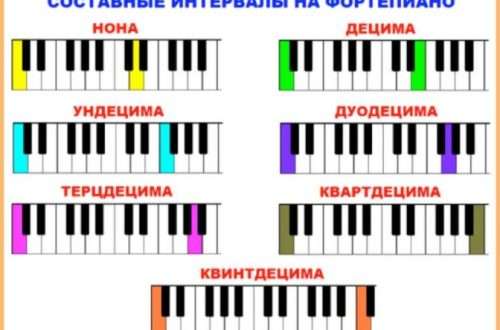We master three types of minor
Contents
In musical practice, a large number of different musical modes are used. Of these, two modes are the most common and almost universal: major and minor. So, both major and minor come in three types: natural, harmonic and melodic. Just don’t be afraid of this, everything is simple: the difference is only in the details (1-2 sounds), the rest of them are the same. Today we have three types of minor in our field of vision.
3 types of minor: the first is natural
Natural minor – this is a simple scale without any random signs, in the form in which it is. Only key characters are taken into account. The scale of this scale is the same when moving both up and down. Nothing extra. The sound is simple, a little strict, sad.
Here, for example, is what the natural scale represents:
3 types of minor: the second is harmonic
Harmonic minor – in it when moving both up and down increases to the seventh level (VII#). It does not rise suddenly, but in order to sharpen its gravity to the first stage (that is, tonic).
Let’s look at the harmonic scale:
As a result, the seventh (introductory) step actually transitions well and naturally into the tonic, but between the sixth and seventh steps (VI and VII#) a “hole” is formed – an interval of an increased second (s2).
However, this has its own charm: thanks to this increased second harmonic minor sounds something like an Arabic (Eastern) style – very beautiful, elegant and very characteristic (that is, the harmonic minor is easily recognizable by ear).
3 types of minor: third – melodic
Melodic minor is a minor in which When the gamma moves upward, two steps increase at once – the sixth and seventh (VI# and VII#), that’s why during the reverse (downward) movement, these increases are canceled, and the actual natural minor is played (or sung).
Here is an example of the melodic form of the same:
Why was it necessary to increase these two levels? We have already dealt with the seventh – she wants to be closer to the tonic. But the sixth is raised in order to close the “hole” (uv2) that was formed in the harmonic minor.
Why is this so important? Yes, because the minor is MELODIC, and according to strict rules, moves to increased intervals in MELODY are prohibited.
What does an increase in levels VI and VII give? On the one hand, there is a more directed movement towards the tonic, on the other hand, this movement is softened.
Why then cancel these increases (alteration) when moving down? Everything is very simple here: if we play the scale from top to bottom, then when we return to the elevated seventh degree we will again want to return to the tonic, despite the fact that this is no longer necessary (we, having overcome the tension, have already conquered this peak (tonic) and go down, where you can relax). And one more thing: we just shouldn’t forget that we are in a minor, and these two girlfriends (elevated sixth and seventh degrees) somehow add fun. This gaiety may be just right the first time, but the second time it’s too much.
The sound of melodic minor fully lives up to its name: it really It sounds somehow special MELODIC, soft, lyrical and warm. This mode is often found in romances and songs (for example, about nature or in lullabies).
Repetition is the mother of learning
Oh, how much I have written about the melodic minor here. I’ll tell you a secret that most often you will have to deal with the harmonic minor, so don’t forget about “Mistress the seventh degree” – sometimes she needs to “step up”.
Let’s repeat once again what three types of minor is in music. It’s a minor natural (simple, without bells and whistles), harmonic (with an increased seventh level – VII#) and melodic (in which, when moving up, you need to raise the sixth and seventh degrees – VI# and VII#, and when moving down, just play a natural minor). Here’s a drawing to help you:
BE SURE TO WATCH THIS VIDEO!
Now you know the rules, now I suggest you watch a simply gorgeous video on the topic. After watching this short video lesson, you will once and for all learn to distinguish one type of minor from another (including by ear). The video asks you to learn a song (in Ukrainian) – it’s very interesting.
Three types of minor – other examples
What is all this we have? What? Are there any other tones? Of course I have. Now let’s look at examples of natural, harmonic and melodic minor in several other keys.
– three types: in this example, changes in steps are highlighted in color (in accordance with the rules) – so I will not give unnecessary comments.
A tonality with two sharps at the key, in the harmonic form – A-sharp appears, in the melodic form – G-sharp is also added to it, and then when the scale moves down, both increases are canceled (A-bekar, G-bekar).
Key: it has three signs in the key – F, C and G sharp. In a harmonic F-sharp minor, the seventh degree (E-sharp) is raised, and in a melodic scale, the sixth and seventh degrees (D-sharp and E-sharp) are raised; with a downward movement of the scale, this alteration is canceled.
in three types. The key has four sharps. In harmonic form – B-sharp, in melodic form – A-sharp and B-sharp in an ascending movement, and natural C-sharp minor in a descending movement.
Tonality. The key signs are flats in the amount of 4 pieces. In the harmonic F minor the seventh degree (E-Bekar) is raised, in the melodic F minor the sixth (D-Bekar) and seventh (E-Bekar) are raised; when moving downwards, the increases are, of course, cancelled.
Three types. A key with three flats in the key (B, E and A). The seventh degree in the harmonic form is increased (B-bekar), in the melodic form – in addition to the seventh, the sixth (A-bekar) is also increased; in the downward movement of the scale of the melodic form, these increases are canceled and B-flat and A-flat, which are in in its natural form.
Key: here, at the key, two flats are set. In the harmonic G minor there is F-sharp, in the melodic – in addition to F-sharp, there is also E-bekar (increasing the VI degree), when moving down in melodic G minor – according to the rule, the signs of the natural minor are returned (that is, F-bekar and E -flat).
in its three forms. Natural without any additional alteration (don’t forget just the B-flat sign in the key). Harmonic D minor – with a raised seventh (C sharp). Melodic D minor – with an ascending movement of the B-bekar and C-sharp scales (raised sixth and seventh degrees), with a downward movement – the return of the natural form (C-becar and B-flat).
Well, let’s stop there. You can add a page with these examples to your bookmarks (it will probably come in handy). I also recommend subscribing to updates on the site page in contact in order to be aware of all updates and quickly find the material you need.



